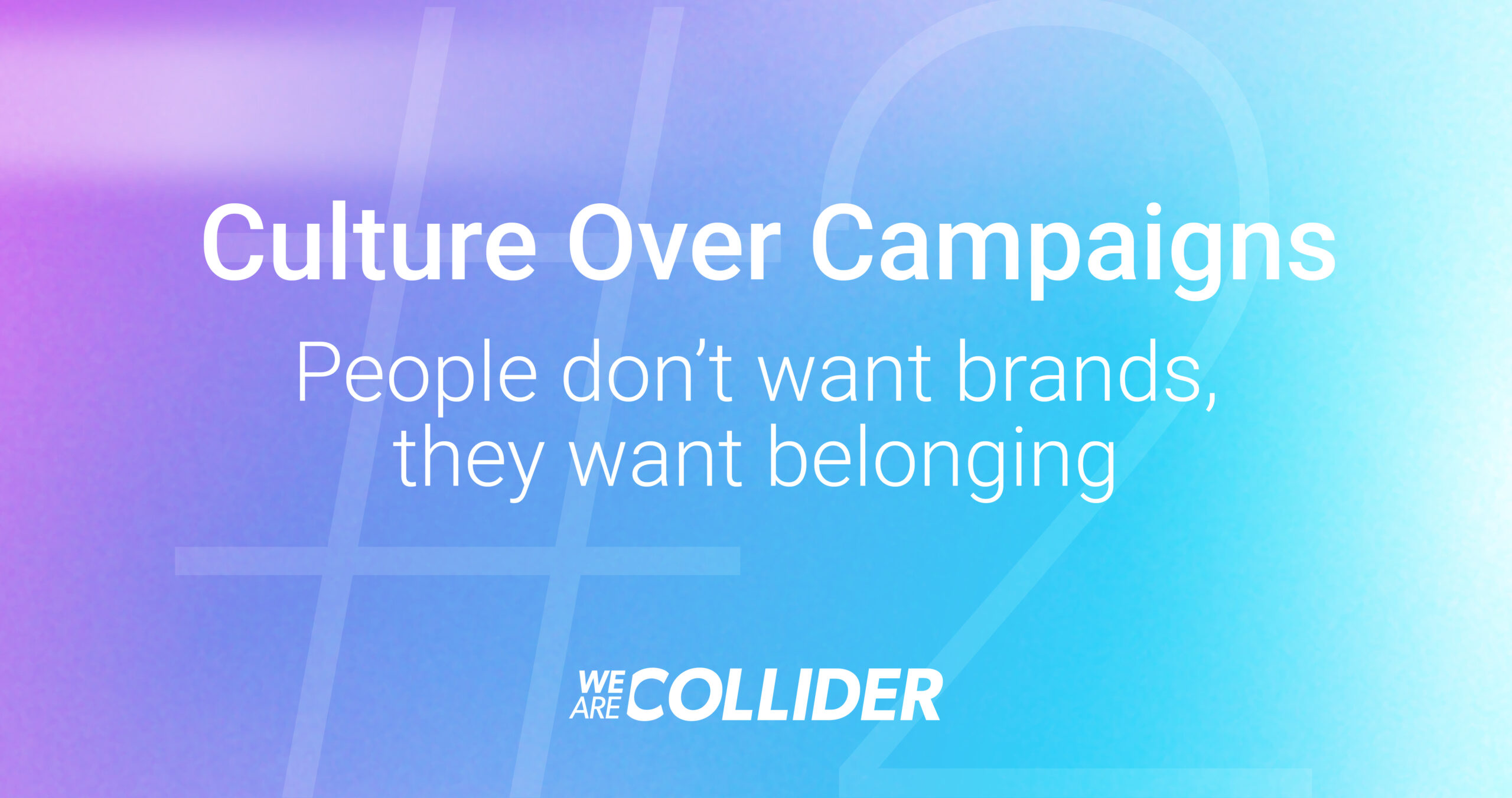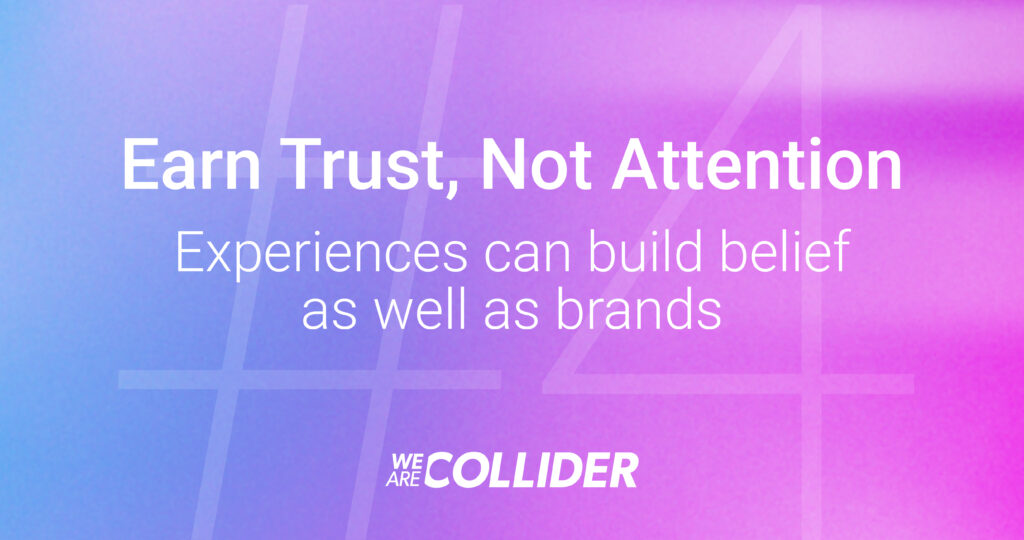A few weeks back, we published our first instalment in a new blog series on experiential brand experiences. For the next month, we’ll be taking a close look at ‘The Experience Index,’ a new and illuminating piece of behavioural research that was developed in collaboration with behavioural scientist Patrick Fagan. The report is founded on our proprietary MARVELS™ framework, based on a nationally representative survey of 2,005 UK adults, and outlines five defining trends that we believe will steer the next chapter of brand experience, namely:
- Duality
- Culture Over Campaigns
- Blended Realities
- Earn Trust, Not Attention
- Turning Moments into Momentum.
In today’s blog, the second of five, we take a look at ‘Culture of Campaigns.’
What is Culture Over Campaigns?
In 2025, audiences are more culturally aware, community-driven, and skeptical of traditional marketing than ever before, meaning brands have to work much harder to make a connection. If people aren’t jaded by what they see, they’re turning to new spaces. In such a saturated media landscape where people are increasingly wise to the tricks of the trade, consumers no longer accept being ‘sold’ to. Instead, they want to feel seen.
In this new context, the brand experiences that really stick are the ones that reflect culture, not just a campaign strategy. The numbers in The Experience Index really emphasised this shift.
55% of interviewees in the 25–34 range said they “want experiences that reflect cultural issues,” 42% of 12–15s said an experience “completely transformed their perception of the brand,” but only 4% of the 65+ group “want behaviour-changing experiences”, and instead want experiences that align with their cultural beliefs. We strongly believe this reflects the new reality that culture is no longer a single, monolithic mass, but a mosaic of micro-communities: sneakerheads, gamers, K-pop fans, conscious foodies. The rise of the creator economy (200M+ global creators), the move from influencers to insiders, and a hunger for authenticity over polish are the real-world forces driving this trend.
Generational insights
The report had a great deal to say on the differences between age groups:
● Gen Z & Gen Alpha: Younger audiences use experiences as ‘identity tooling.’ They seek transformation, identity play and cultural relevance. Participation beats polish, and experiences can often be vehicles for activism, self-expression and change. They prize insider voices over mega-influencers, prefer co-creation and remix culture, and want moments that reflect subcultures.
● Millennials: This cohort values cultural fluency and co-creation. They want experiences that reflect their passions and subcultures, but with a layer of utility or storytelling. That means co-designed events, workshops, and meaningful brand collaborations that let them learn, connect and contribute, work best.
● Gen X & Boomers: Older groups tend to look for confirmation and emotional resonance. They respond to authenticity rather than activism, and value experiences that align with their lived history and values. They are less likely to seek behavior-changing experiences and instead reward clarity, craft, and meaning.
Takeaways for brands
For younger audiences, success depends on tapping into culture from the inside out. Brands should partner with cultural insiders, such as creators, artists, or activists, who genuinely live within the communities they’re trying to reach. In this landscape, credibility always beats reach. Audiences can tell instantly whether a collaboration is authentic or opportunistic.
It’s essential, therefore, for brands to ditch the generic and build brand experiences around real passions. Every micro-community has its own language, rituals and codes of belonging, so the smartest brands are those that learn those rules before they start designing. Finally, brands should design for ‘identity play,’ which is a very Gen Z way of saying that they need to provide the tools for participants to express who they are or who they want to become. Whether through costume elements, customisable merch, editable soundtracks or AR avatars, the goal is to let audiences use the experience as a canvas for self-expression.
For older audiences, the formula is different but equally human. Authenticity matters more than activism. These audiences want to hear a brand speak from the heart, not a hashtag. It’s about demonstrating values through craft, quality and consistency. Novelty for novelty’s sake simply won’t land, so what will resonate is an experience built on shared stories, rituals and emotional truth.
Across both old and young, brands should always be designing for micro-communities, not mass audiences. Try to measure cultural fit as well as footfall, involve insiders in co-authoring the experience, and modularise engagement so people can choose their level of involvement. Above all, treat cultural fluency as a core competency, not an afterthought.
In conclusion: experiences we’re fans of
At We Are Collider, we’re proud of the work that gets culture right. A great way to wrap up this blog is to look at a brand experience that really nailed the idea of ‘Culture over Campaigns.’ Urban Decay’s ‘Face Bond,’ for example (one of our own activations), really tapped into this concept. It combined CGI storytelling, shade-matched PR kits and interactive billboards to create a multilayered, identity-rooted moment. It didn’t just launch a product, it helped spark a community conversation about identity, representation and self-expression.
The result? Urban Decay’s launch stood out from the sea of generic beauty campaigns. Instead of sticking to a single channel, the activation blended digital and physical touchpoints to reach audiences wherever they were. Influencer unboxings brought authenticity and buzz, CGI storytelling built anticipation, and interactive billboards turned curiosity into participation.
Want to design a brand experience that balances fun with meaning to build belonging?
Speak to Anton Jerges to explore how The Experience Index and MARVELS™ can elevate your next activation: anton.jerges@wearecollider.com





